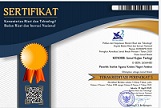FACEBOOK : A Product Of Popular Culture And The Virtual Interreligious Dynamics
Abstract
Popular Culture especially Facebook has become a part our everyday life. Religious communities such as church is also using this media of communication to support its ministerial purposes. In this article, I try to explore about the ideas of Facebook in order to see to what extend this media has already contributed not merely for any particular religion, but also for strengthening interreligious relations. This article begins with a consideration on why we should pay attention on Facebook in our theological discourses, followed by a brief description why it has been said as a form of popular culture. In the next section, I will analyze social, existential or hermeneutical, and transcendent dimensions functions of Facebook setting out from Gordon Lynch’s theory. In the end, I will specifically highlight how Facebook can contribute for interreligious dynamics. This part ends up with three considerations that Facebook has built an online interreligious community, increased public awareness on social and political issues, and bridged the gap in the spatially-segregated community.
Keywords
Full Text:
PDFReferences
Ansori Mohammad Hasan et all., “Post-Conflict Segregation, Violence, and Reconstruction Policy in Ambonâ€, a research result (online version) by National Violence Monitoring System (SNPK), the Habibie Center.
Budiman Hikmat, 2002. Lubang Hitam Kebudayaan, Yogyakarta: Kanisisus.
Campbell Heidy, 2006. “Religion and the Internet†in Communication Reserach Trens Vol. 25 No.1.
Cobb Kelton, 2005. Theology and Popular Culture. Malden: Blackwell.
Gruzd, Anatoliy, Barry Wellman and Yuri Takhteyev, 2011. “Imagining Twitter as an Imagined Communityâ€, in American Behavioural Scientist.
Ibrahim Idi Subandy, 2011. Kritik Budaya Komunikasi. Yogyakarta: Jalasutra.
Illman Ruth and Sofia Sjo, 2015. “Facebook as a Site for Interreligious Encounters: A Case Study from Finland†in Journal of Contemporary Religion Vol. 30.
Lovheim Mia, 2015. “Young People and the Use of Internet As Transitional Space†in Heidelberg Journal of Religions on Internet 1.1.
Lynch Gordon, 2005. Understanding Theology and Popular Culture. Malden: Blackwell.
Marsh Clive and Vaughan S. Roberts, 2012. Personal Jesus.How Popular Music Shapes Our Souls. Michigan: Baker Academic.
McCracken Brett, 2010. “The Separation of Church and Status: How Online Social Networking Helps and Hurts the Church†in The Princeton Theological Review Vol. XVIII, No. 2.
Sholeh Badrus, 2014. “The Dynamics of Moslem Christian Relations in Ambon, Eastern Indonesia†in International Journal of Bussiness and Social Science Vol. 4. No. 3.
Other sources:
Teaching material for Theology and Popular Culture formatted in Microsoft Power Point entitled “Perdebatan Akademis Tentang Budaya Populer†(translated by the author as “Academic Debate on Popular Culture), Post Graduate Program of Theology, UKDW, 2012.
www.statista.com accessed on 25 May 2018.
DOI: https://doi.org/10.37196/kenosis.v4i1.51
Refbacks
- There are currently no refbacks.
Copyright (c) 2019 KENOSIS: Jurnal Kajian Teologi

This work is licensed under a Creative Commons Attribution-NonCommercial-ShareAlike 4.0 International License.
Jurnal Kenosis Telah Terdaftar Pada Situs:
This work is licensed under a
Creative Commons Attribution-ShareAlike 4.0 International License.
Copyright © Kenosis: Jurnal Kajian Teologi 2015-2022. All Rights Reserved.



